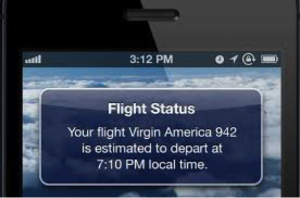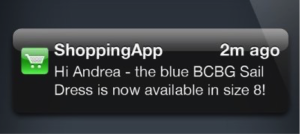This is a guest blog post by Atibhi Mehra – specialist in mobile space
As I was waiting to board my flight, I got just another – push notification. My first instinct was to ignore it but this time I read closely, this notification informed me of the restocking of a particular set of rechargeable batteries I wanted desperately and were out of stock.
Was this information of value ? Surely . Did I click on the notification and go to the app? Of course, I did. Did this provider manage to make a mark among other shopping apps I have? Motivate me to get back to the app? You bet it did
With engagement rightly becoming a key metric marketers are driving towards and sure, apps have proved to rank highest in terms of time spent , purchase value and involvement. Using push notifications and in-app messaging seem to be the tool everyone is using with or without caution
What needs to be understood, unlike most forms of advertising, the consumer here is in the driving seat, he has the option of turn off notifications from your app in the phone settings. You have one chance and that’s why careless use is avoidable. There are very distinct cases that prove to be effective in push notifications.
Keep a close watch on F.A.C.T.S
- Frequency : Use for specific events, triggers and preferably not more than 2-3 a week per unique user
- Analytics : It is important to get sophisticated in your analysis of your users through event tracking, retention analysis and life time value LTV reporting right in the beginning. You will see connections between particular actions, repeat app usage, and revenue. Unless you know this you cant identify what trigger points you should use for notifications
- Content : Be crisp clear and concise. 10-12 words work well. Give the purpose, value and reward. Avoid sending direct product messages , try to build in some value related to the product / offering to the user
- Timing : As per an article from localytics Best Practice is to send these between noon and 5pm, weekdays between Tuesday to Friday. If you are a global app, configure push messages by taking care of different time zones
- Sharp Targeting: It is critical to use your audience segments based on in-app behaviour to send push messages centred on this criteria.Spamming is a bad idea. When a push message isn’t relevant to someone, they will view it as spam
Examples of successful push notifications

Example of push notification
Information: Informing users of critical information that they would otherwise need to seek actively. A good example is of travel apps that reduce frustrations by providing critical trip information such flight status updates, airport security alerts, traffic condition to the airport, destination weather advisories

Reminder mechanism
Timely Reminders: Think of Alarm, calendar, to-do list and other time sensitive apps ,sending user-specified reminders. It can also work for mCommerce apps when used correctly to remind users of items left in their cart, upcoming sales, and even product re-stocks or availability, similar items available , drop in price of a saved item
Special Offers: Provide a tailor-made experience for their users based on user behaviour For example, if a set of users always buy or browse through Nike brand products in your mCommerce app, they would likely appreciate and engage with a push message about a new Nike product.
mCommerce apps can also use push messaging campaigns to promote special offers or mobile only offers , however should be used in frequently given that users don’t typically want to be bombarded by coupons and notifications. You see this with most commerce sites in India
Re engage latent users: The most common challenge for content or media apps is to convert passive users to active subscribers. Without the right incentive, those who casually view content on your app won’t pay to subscribe for access to your best features and articles for media apps
There are many tools to trigger notifications and here is a List I found handy
In app messaging is another form of driving engagement with the user, and that has specific use cases too . Watch out for more in this space






